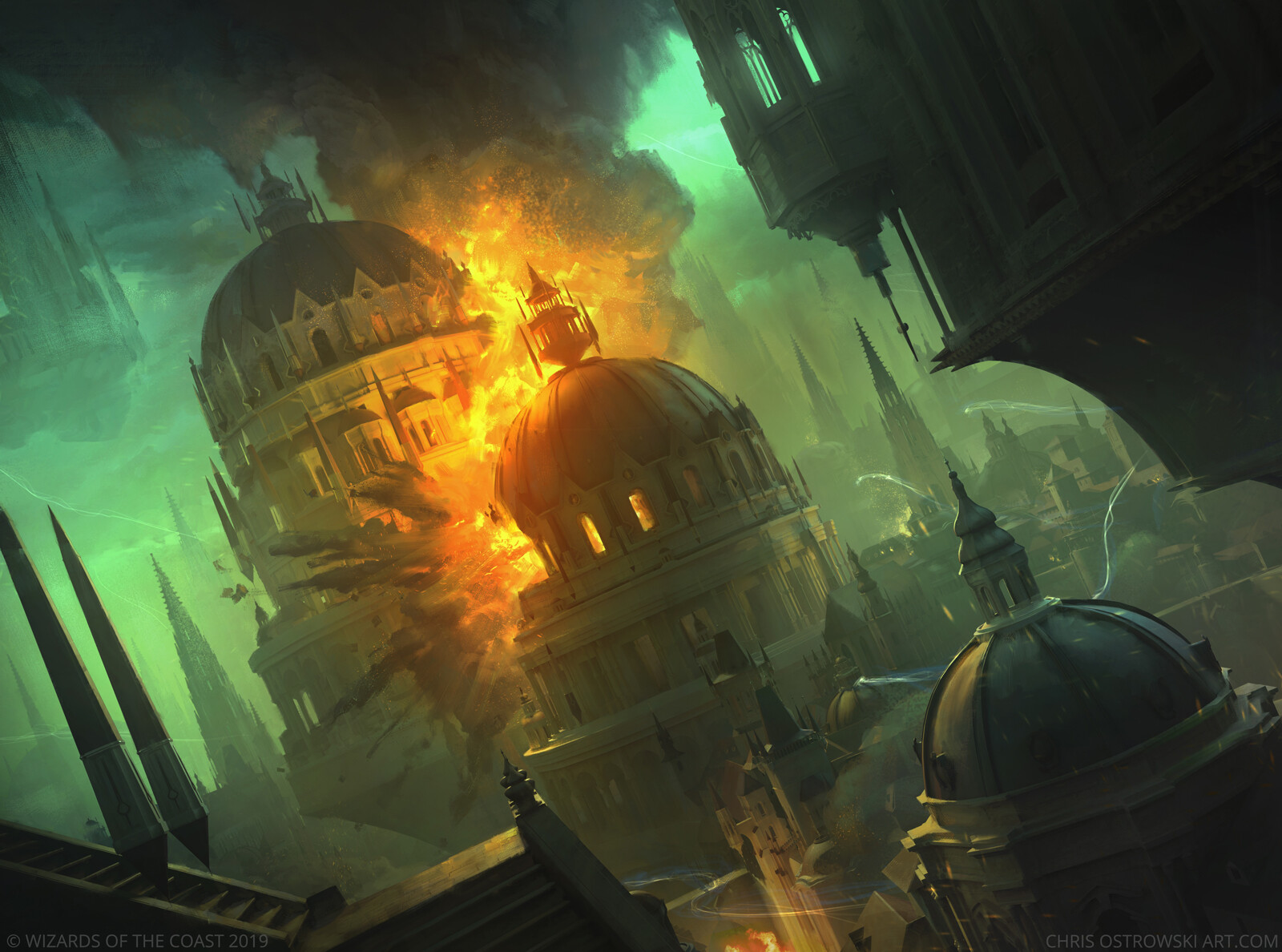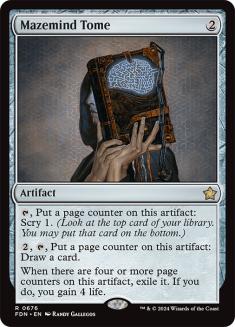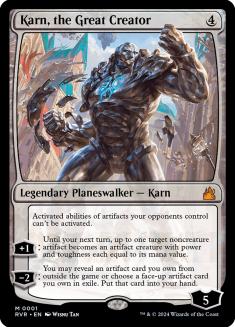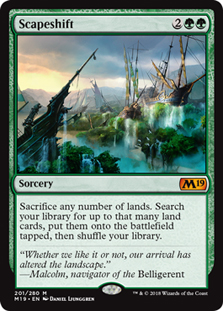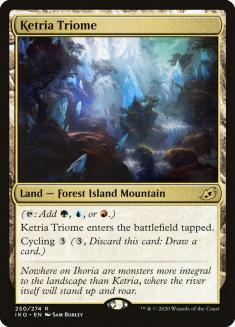On Monday, July 13, Wizards of the Coast (WotC) banned Arcum’s Astrolabe in Modern. That very morning, I sent the following message to our own Cedric Phillips on Slack while brainstorming article topics:
As for Modern, the Astrolabe ban kills control which pushes the format back to aggro (goblins, blitz/mono-red prowess) vs big mana (tron, Etron and Amulet.)
The subsequent week, I messaged Cedric on Slack again, talking about Modern Temur Scapeshift and its impending rise among the (now four) big mana decks that make up a large slice of the Modern metagame pie. (As with a great many innovations and predictions in metagame shifts, I was turned on to this one a few days ahead of time by the inimitable King of the SCG Tour, Andrew Jessup.)
Now, we see three sizable tournaments in Modern this week won by big mana decks. Eldrazi Tron and Temur Scapeshift won the Modern Challenge on Magic Online and the ManaTraders Modern Series, respectively. Then Temur Reclamation won the Split Championship Qualifier out of nowhere! This is 100% predictable, and a natural consequence of the pressures of the format.
It also means the format is exploitable. But let’s not get ahead of ourselves.
The three winning lists:
Creatures (15)
Planeswalkers (6)
Lands (24)
Spells (15)

Creatures (4)
Lands (26)
Spells (30)
- 4 Lightning Bolt
- 1 Forest
- 2 Island
- 3 Opt
- 4 Remand
- 4 Cryptic Command
- 4 Scapeshift
- 2 Izzet Charm
- 4 Growth Spiral
- 2 Wilt
Sideboard

Creatures (4)
Planeswalkers (1)
Lands (23)
Spells (32)

Big mana strategies are on top of the metagame now, and it’s not hard to see why. Scapeshift has been an ebb-and-flow part of Modern ever since Valakut, the Molten Pinnacle was unbanned way back in late 2012. And Urzatron decks have been part of the format for even longer, pretty much since the very beginning!
One of the easiest ways to win a game of Magic is to do more things with your mana. Cast more expensive cards earlier in the game, and overwhelm your opponent. Gaining a mana advantage is the most straightforward way to overpower your opponent; either you’ll be doing more things than they are, or the things you are doing are more powerful than theirs. Reductive? Maybe. A useful heuristic? Absolutely.
It says something about the power of big mana decks that even during the regimes of some of the most oppressive, overpowered decks (Ironworks, Hogaak, Urza/Oko, Melira Pod, Eldrazi Winter, and more), there has always been a big mana deck competing in the metagame. Summer Bloom was even banned from the more egregious versions of Amulet Titan and the deck has remained a powerful piece of the Modern puzzle.
If you want to get into Modern, now is a fine time, with more intuitive (yet still powerful) decks like Temur Scapeshift and Eldrazi Tron looking well-tuned and well-positioned at the moment.
Eldrazi Tron
What is there to say about this powerful blend of mana acceleration inherent in both the Urzatron and Eldrazi Temple that hasn’t already been said? You’re always doing something powerful, you don’t fold to any particular piece of interaction, and you have more flexibility now than any colorless deck ever has had before due to the power of Karn, the Great Creator as a double Wish effect.
With Core Set 2021, you even add Mazemind Tome as a replacement for Mind Stone. Scrying a couple times in the early- and mid-game, drawing a card or two in the late-game, and popping for a cool four life is nothing to ignore.
The downside of playing Eldrazi Tron is that you have barely any sideboard to speak of, and if you have dead cards in your maindeck, you may not have much in the way of an upgrade when it comes time to think about sideboarding. Against a creatureless deck, for example, you have Dismember; All Is Dust; and possibly Ugin, the Ineffable to look to remove. You could sideboard in a pair of Relic of Progenitus, but a lot of the singletons in your sideboard are better left there to be found by Karn than slipped into your deck where you’re unlikely to find them when you need them.
How do you sideboard against Temur Scapeshift, for example? You don’t have five good cards to bring in. You don’t really have any good cards to bring in. You just accept that you have a bunch of weak cards even post-sideboard. Relic of Progenitus and a fourth Walking Ballista are better than All Is Dust and Dismember, but not by much. This is the price you pay for playing a colorless deck with a Karn sideboard.
A charitable view of the deck might consider this to be a feature, not a bug, especially where newer players are concerned. After all, if you don’t have the ability to get creative with your sideboarding, you can’t screw it up too badly. This isn’t the worst logic, but it still feels strange looking at a deck and knowing you can’t do anything to change your strategy between games.
Temur Scapeshift
The great part about Temur Scapeshift is that it’s essentially a control deck that just happens to win the game once it ramps to the requisite seven or eight lands. It gets to play Uro, Titan of Nature’s Wrath and Growth Spiral, two cards that should have been banned in Standard but keep kicking around for some reason. It’s got Lightning Bolt and Izzet Charm for cheap creatures, Remand and Cryptic Command to fight any counterspell war necessary, and Wilt to catch random artifacts and enchantments. The great thing about Temur Scapeshift is that it can easily win on Turn 4 or 5 while still casting an interactive spell or two, but it can win with four counterspells of backup all the way on Turn 12. And with Uro as a backup win condition and must-answer threat, the deck is no longer as vulnerable to an effect like Necromentia on Valakut, the Molten Pinnacle.
Additionally, now that Ketria Triome exists, the deck that has mana requirements like 2GG and 1UUU can now also sport a full twelve Mountains while running a pair of Islands and Mystic Sanctuaries. It’s a very welcome, if subtle, improvement to the manabase. Incidentally, Mystic Sanctuary is quite the card for this deck as well. One of the best ways to beat Scapeshift decks historically has been to hit them with some Thoughtseizes to rip the namesake spell out of their hand. Now, there’s absolutely no way to stop them from fetching up an end-step Sanctuary, putting the Scapeshift back on top, and winning the very next turn.
This deck doesn’t run out of Scapeshifts anymore.
It also gets to leverage the now-classic “Snapcaster Mage effect,” where a narrow, powerful sorcery or instant has double the impact because every time you draw it, you know that you will be able to cast it multiple times during the game. Anger of the Gods can sweep Dredge multiple times. Wilt can eat the Expedition Map on Turn 2 and the Mystic Forge on Turn 7. I’m surprised that there are no copies of Veil of Summer in the sideboard, as re-using a card like that, especially against a deck that packs Thoughtseize and Stubborn Denial (do we know any Modern decks that play those two cards, folks?) would be an absolute beating.
Temur Reclamation
To be frank, this deck appears to be a slightly worse version of Temur Scapeshift to me. However, it won the biggest event of the weekend, so take this critique with a grain of salt.
Temur Reclamation is attempting to leverage a big mana advantage to cast a large number of four-mana spells, like Fact or Fiction and Cryptic Command and Wilderness Reclamation. These are powerful spells, no doubt. But they don’t win the game the same way Scapeshift does. I’d much rather have a four-mana spell that wins the game and protect that with Veil of Summer than have a four-mana spell that does nothing without other powerful spells to keep the gas flowing.
Field of the Dead is how Temur Reclamation hopes to eventually win the game (along with repeated casting of Nexus of Fate, another expensive card). The Cryptic Command + Mystic Sanctuary lock is cute, but it still doesn’t offer anything that Temur Scapeshift doesn’t already include.
Incidentally, the mana in Temur Reclamation looks worse than that of Temur Scapeshift. Field of the Dead, Blast Zone, and multiple off-color basics in a deck with Archmage’s Charm? Count me out.

The deck does look like a whole lot of fun, though, for what it’s worth! And it’s harder to hate out directly (though Stubborn Denial and Disdainful Stroke might count as hate cards, to be fair).
Beyond Big Mana
There are alternatives for those who want to play with cheap creatures that attack for large chunks of damage.
Not only is Four-Color Death’s Shadow a playable archetype right now, two versions of Prowess (Rakdos and Izzet) are winning quite a few games themselves. I don’t always play these Prowess decks, but I always respect them. With cards like Bedlam Reveler and Light Up the Stage, they’re never out of any game.
Now, Izzet Prowess is not quite Izzet Phoenix, but this deck is proactive, powerful, flexible, and resilient. It also leaves a ton of room for flexibility. You can play with cards like Molten Rain, Snapcaster Mage, Dragon’s Claw, Izzet Charm, or even Spell Snare! I wouldn’t hesitate to recommend it as the flexible tempo deck that can turn into a control deck if that’s your cup of tea.
Creatures (17)
Lands (15)
Spells (28)
- 4 Lightning Bolt
- 3 Mountain
- 3 Opt
- 4 Lava Dart
- 4 Manamorphose
- 2 Burst Lightning
- 2 Mutagenic Growth
- 3 Gut Shot
- 3 Light Up the Stage
Sideboard

I have softened on Grixis Death’s Shadow since every other deck seems to have gotten a major power boost over the last year or so, but Four-Color Death’s Shadow is still alive and kicking, with cards like Nurturing Peatland offering flood insurance and a source of juicy self-inflicted life loss.
Lurrus of the Dream-Den is still an appealing card to try to make work in a more midrange Death’s Shadow deck in the future, and I’m surprised that (despite the significant downgrade) it’s not a companion for any version of the deck, but I wouldn’t be surprised to learn that some multicolor Death’s Shadow or Jund Death’s Shadow deck is actually the best place for a card like that.
Creatures (10)
Planeswalkers (3)
Lands (18)
Spells (29)

Boil sure is a nice touch against all the big mana Temur decks floating around! And Nihil Spellbomb can loop with Lurrus to beat Dredge singlehandedly. You add a few copies of Necromentia to fight a mix of Dredge, Scapeshift, Mono-Green Tron, and combo decks, but the metagame still has a ways to go to sort out exactly what interactive cards need to go where.
It will be very interesting to watch the battle play out between the Growth Spiral and Urzatron decks against the decks that play cheap creatures, but Modern has a semblance of balance that has been sorely missing from Standard and Pioneer as of late. It’s one of the few formats I’m excited to play!

